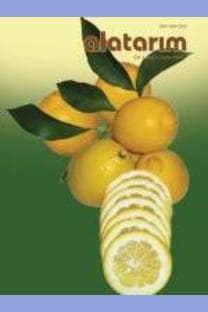Chayote (Sechium edule(Jacq.) Swartz) yetiştiriciliği
kültivasyon, Sechium edule, Antalya, Hatay, uyum
Chayote (Sechium edule(Jacq.) Swartz) growing
cultivation, Sechium edule, Antalya, Hatay, adaptation,
___
- Anonymous, 2004. USDA National Nutrient Database for Standard Reference, Release 17,http://www.nal.usda.gov/fnic/foodcomp/cgi-bin/list_nut_edit.pl (13.01.2005).
- Anonymous, 2005. The Mildred E.Mathias Botanical Garden.UCLA Web Page, http://www.botgard.ucla.edu/html/botanytextbooks/economicbotany/Cucurbita/bl266tx. html (3.03.2005).
- Aung, L. Hi, Ball, A., Kushad, M., 1990, Developmental and Nutritional Aspects of Chayote (Sechium edule, Cucurbitaceaej. Economic Botany. 44(2): 157-164.
- Engels, J.M.M., Jeffrey, C, 1993. Sechium edule (Jacq.) Swartz. (J.S. Siemonsma ve K. Piluek,editörler.) Plant Resources of South-East Asia. No. 8. Vegetables. Pudoc Scientific Publishers, Wageningen. 246-248.
- Hord, M-, Villalobos, W., Macaya-Lizano,A. V., Rivera, C, 1997. Chayote-Mosaic, a New Disease in Sechium edule Caused by a Tymovirus. Plant Disease. 81(4):374-378.
- Lira, R., Chiang, F., 1992. Two New Combinations in Sechium (Cucurbitaceae) from Central America and A New Species from Oaxaca, Mexico. Novon 22:227-23 1.
- Lira, R., Soto, J.C., 1991. Sechium hintonii (P.G. Wilson),C. Jeffrey (Cucurbitaceae).Rediscovery and Observations. FAO/IPBGR Plant Genet. Res. Newsletter 87:5-10
- Newstrom, L.E., 1991. Evidence for the Origin of Chayote, Sechium edule (Cucurbitaceae).Economic Botany. 45(3): 410-428.
- Robinson, R.W., Decker-Walters, D.S., 1997. Cucurbits. CAB International, Wallingford, U.K.
- Rubatzky, V.E., Yamaguchi, M., 1997. World Vegetables (Principles, Production and Values, Second Edition). International Thomson Publishing, New York, USA. 842.
- Saade, R.L., 1996. Chayote, Sechium edule (Jacq.) Sw. Promoting the Conservation and Use of Underutilized and Neglected Crops. 8. Institute of Plant Genetics and Crop Plant Research, Gatersleben/International Plant Genetics Resources Institute, Rome, Italy.
- ISSN: 1304-2653
- Yayın Aralığı: 2
- Başlangıç: 2015
- Yayıncı: Alata Bahçe Kültürleri Araştırma Enstitüsü
Türkiye tarım ürünleri dış ticaret yapısı ve gelişimi
Hüseyin KARATAŞ, Y.Sabit AĞAOĞLU
Düşük sıcaklıkların tohum çimlenmesi üzerine etkileri
AHMET KORKMAZ, İSKENDER TİRYAKİ
GÜLTEKİN ÖZDEMİR, SEMİH TANGOLAR, Halil ERDEM, HATİCE BİLİR EKBİÇ, MUSTAFA BÜLENT TORUN
Karniyol arısı'nın (Apis mellifera carnica Pollm 1978) Türkiye arıcılığı için önemi
AYDIN UZUN, TURGUT YEŞİLOĞLU, Önder TUZCU
